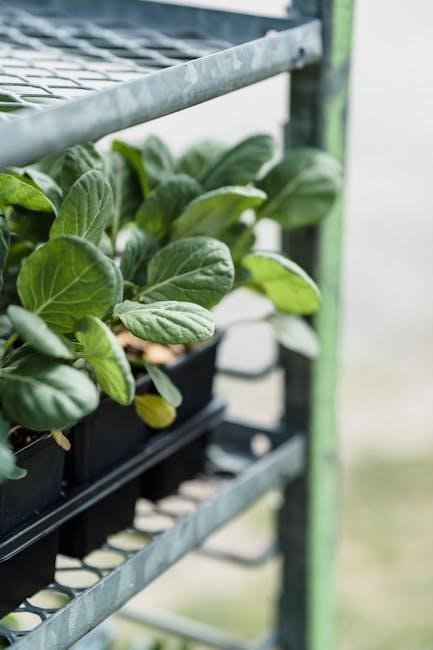
The Jiffy Seed Starting Greenhouse Kit is a popular choice for gardening enthusiasts, offering biodegradable peat pots that minimize transplant shock and promote healthy seedling growth indoors.
Overview of the Jiffy Greenhouse Kit
The Jiffy Seed Starting Greenhouse Kit is a user-friendly system designed for indoor seed germination and early plant growth. It includes biodegradable peat pellets that expand with water, creating a nutrient-rich medium for seeds. The clear plastic humidity dome helps maintain consistent moisture and warmth, ideal for seedling development. This kit is perfect for gardeners of all skill levels, offering a mess-free and efficient way to start seeds indoors. Its compact design allows for easy placement on windowsills or countertops, making it a practical choice for small spaces. The Jiffy Greenhouse Kit is widely praised for its ability to promote healthy root growth and minimize transplant shock when moving seedlings to larger pots or directly into the garden.
Materials Needed for the Jiffy Seed Starting Kit
The Jiffy Greenhouse Kit includes a compact tray, biodegradable peat pellets, a clear humidity dome, and a base tray for water absorption and seed germination.
- Peat pellets expand when soaked in warm water.
- Seeds and potting mix must be purchased separately.
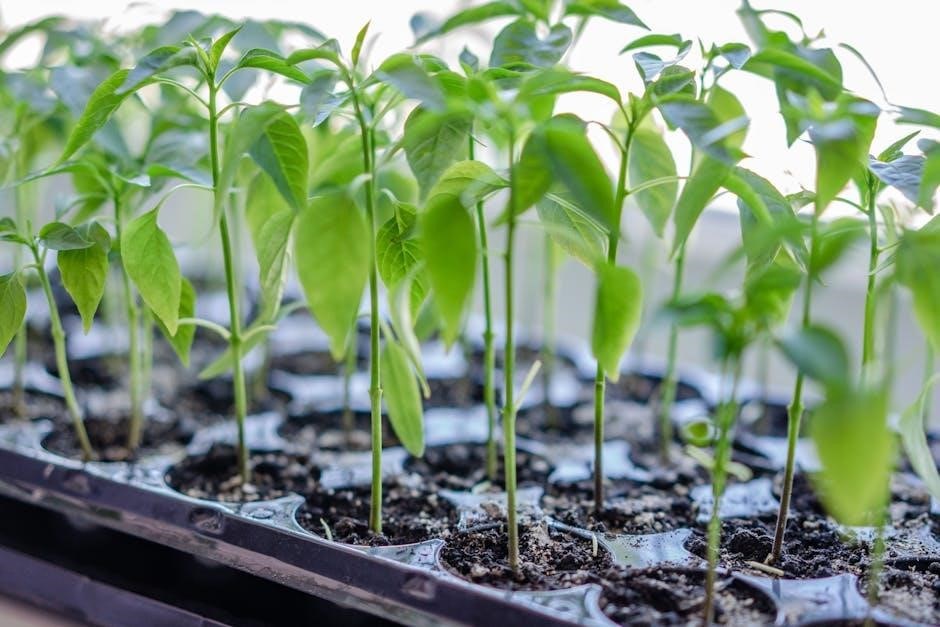
Components of the Jiffy Greenhouse Kit
The Jiffy Greenhouse Kit is designed for convenient seed starting and includes several key components to ensure successful germination and healthy seedling growth.
- Compact Tray: A sturdy base tray that holds water and supports the peat pellets during the germination process.
- Biodegradable Peat Pellets: Made from compressed peat moss, these pellets expand when soaked in warm water, creating a nutrient-rich growing medium for seeds.
- Clear Humidity Dome: A transparent plastic cover that fits over the tray to maintain humidity and promote seed germination by creating a mini-greenhouse effect.
- Seed Starting Cells: Individual cells within the tray provide ample space for each seed to grow without overcrowding.
These components work together to create an ideal environment for seedlings to thrive, making the Jiffy Greenhouse Kit a user-friendly option for gardeners of all skill levels.
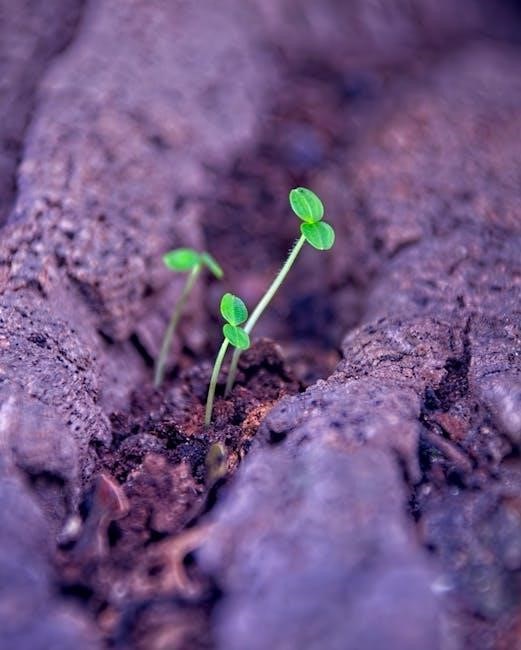
Step-by-Step Instructions for Using the Jiffy Seed Starting Greenhouse
Follow these easy steps to successfully start seeds indoors using the Jiffy Greenhouse Kit, ensuring optimal germination and healthy seedling growth for your garden.
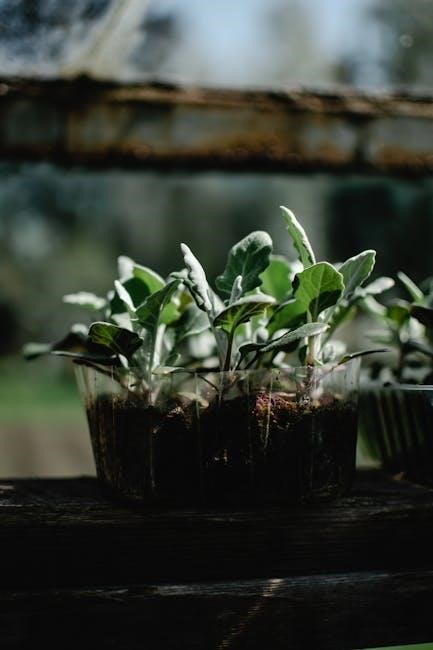
Step 1: Preparing the Jiffy Greenhouse
To begin, place the Jiffy Greenhouse tray on a flat, stable surface; Open the package containing the peat pellets and distribute them evenly into the tray compartments. Next, pour warm water into the bottom of the tray until the peat pellets absorb the water and expand to approximately 7 times their original size. Allow the pellets to fully hydrate, which may take a few minutes. Once expanded, gently tear open the top netting of each pellet to create a small planting area. Ensure the pellets are moist but not waterlogged. If there is excess water in the tray, carefully pour it out to prevent over-saturation. The greenhouse is now ready for sowing seeds. This step ensures optimal conditions for seed germination and healthy root development.
Step 2: Sowing the Seeds
Once the peat pellets are prepared, carefully open the netting on each pellet to create a small planting area. Place one or two seeds in the center of each pellet, depending on the seed size and germination rate. For larger seeds, plant one per pellet; for smaller seeds, two can be placed. Ensure the seeds are sown at the correct depth, as specified on the seed packet. Gently press the seeds into the peat mix to secure them. Avoid sowing seeds too deeply, as this can hinder germination. Once all seeds are placed, cover them with the netting or a thin layer of peat mix. This step ensures even germination and provides the seeds with the right conditions to grow. Proper spacing and depth are crucial for healthy seedling development.
Step 3: Watering and Covering the Seeds
After sowing the seeds, gently water the peat pellets using lukewarm water. Ensure the pellets are moist but not waterlogged, as excess moisture can lead to poor germination. Pour water into the bottom tray until the pellets have absorbed enough to maintain a damp consistency. Once the seeds are watered, cover the greenhouse with the clear humidity dome provided. This dome helps retain moisture and create a warm, humid environment conducive to germination. Place the greenhouse in a warm, bright location, such as a sunny windowsill or under grow lights, but avoid direct sunlight, which may cause overheating. Check the greenhouse daily to ensure the pellets remain moist but not soggy. Proper watering and covering are essential for promoting healthy seed germination and maintaining optimal growing conditions.
Step 4: Monitoring and Maintaining the Greenhouse
Regular monitoring is crucial for maintaining optimal conditions in the Jiffy Greenhouse. Check the peat pellets daily to ensure they remain moist but not waterlogged, as excessive moisture can lead to mold and poor germination. If the pellets start to dry out, add a small amount of warm water to the bottom tray. Keep the greenhouse in a warm, bright location, such as a sunny windowsill or under grow lights, avoiding direct sunlight to prevent overheating. Open the humidity dome slightly if condensation builds up excessively, allowing for airflow without letting the pellets dry out. Maintain a consistent temperature between 65-75°F (18-24°C) to promote germination. Avoid overwatering, as this can hinder seedling growth. By closely monitoring and adjusting conditions, you ensure a healthy start for your seeds, setting them up for strong and vigorous growth.
Step 5: What to Do When Seeds Sprout
Once seeds sprout, it’s essential to adjust the greenhouse conditions to support healthy growth. Start by reducing humidity to prevent mold and rot. Gently open the clear humidity dome a little more each day to gradually acclimate the seedlings to drier air. Ensure the peat pellets remain moist but not waterlogged, as overwatering can harm delicate roots. Provide indirect light or move the greenhouse to a bright, sunny location, such as a windowsill, to promote photosynthesis. Avoid direct sunlight, which can cause overheating. Maintain consistent temperatures between 65-75°F (18-24°C) to encourage robust growth. Keep monitoring the seedlings daily, and once they have 2-3 sets of leaves, they are ready for the hardening-off process before being transplanted outdoors.
Step 6: Harden Off and Transplant
Once seedlings have 2-3 sets of leaves, it’s time to harden them off before transplanting. Start by moving the greenhouse to a shaded outdoor area for 1-2 hours daily, gradually increasing exposure to sunlight and wind over 7-10 days. Avoid direct sun, which can stress the seedlings. Bring them indoors each night to protect from cool temperatures. When fully acclimated, carefully remove the biodegradable peat pots, taking care not to disturb the roots. Plant the seedlings in well-prepared soil in larger pots or directly into the garden, burying them up to their first leaves. Water thoroughly after transplanting and keep the soil consistently moist during the first week. This process ensures a smooth transition and minimizes shock, giving your seedlings the best chance to thrive in their new environment.
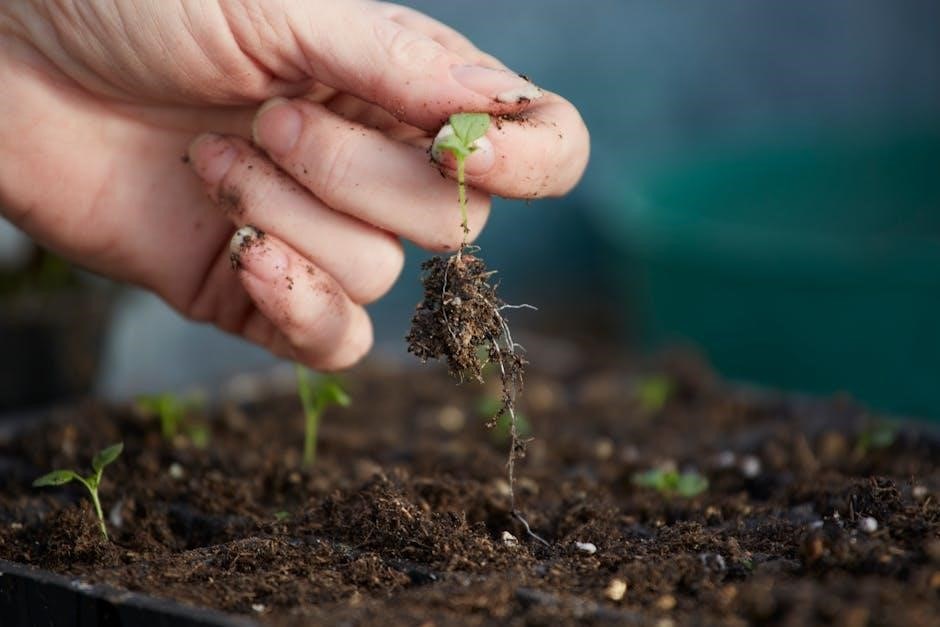
Tips for Successful Seed Starting with Jiffy Greenhouse
Use high-quality potting mix, avoid overwatering, and provide adequate light. Maintain consistent moisture and ensure proper air circulation to prevent mold growth for optimal seed germination and healthy seedlings.
Best Practices for Using Jiffy Peat Pellets
For optimal results with Jiffy Peat Pellets, start by soaking them in warm water until they expand to 7 times their original size. Gently tear open the netting to avoid breaking the pellet. Sow seeds at the recommended depth on the seed packet, ensuring proper contact with the growing medium. Avoid overwatering, as this can lead to mold and poor germination rates; Once seeds germinate, provide indirect light to promote healthy growth. Maintain consistent moisture but ensure good drainage to prevent waterlogged soil. Keep the greenhouse in a warm location, ideally between 65-75°F, to encourage seedling development. After seedlings emerge, gradually acclimate them to outdoor conditions before transplanting. Handle the biodegradable pellets carefully to avoid breaking, as this can disrupt root growth. By following these practices, you can achieve robust and healthy seedlings ready for transplantation.
Troubleshooting Common Issues
When using the Jiffy Seed Starting Greenhouse Kit, common issues can arise, such as poor germination or mold growth. Check that the peat pellets are sufficiently watered but not waterlogged, as excess moisture can lead to mold. Ensure seeds are sown at the correct depth and that the greenhouse is placed in a warm, draft-free location. If seeds fail to germinate, verify that the temperature is within the recommended range (65-75°F) and that the pellets are consistently moist but not soggy. Overwatering can also cause the pellets to break down, disrupting root growth. If mold appears, improve ventilation by slightly opening the humidity dome. Avoid direct sunlight, which can cause overheating and stress to seedlings. By addressing these issues promptly, you can ensure healthy seedling development and a successful start to your garden.
The Jiffy Seed Starting Greenhouse Kit is an excellent tool for gardeners of all skill levels, providing a simple and effective way to start seeds indoors. Its biodegradable peat pellets minimize transplant shock, and the clear humidity dome ensures optimal conditions for germination. By following the step-by-step instructions and maintaining proper care, you can successfully grow healthy seedlings. Remember to monitor water levels, provide adequate light and warmth, and transition seedlings gradually to outdoor conditions. With the Jiffy Greenhouse Kit, you can enjoy the satisfaction of nurturing your plants from seed to maturity, making it a valuable addition to your gardening routine. Happy gardening!